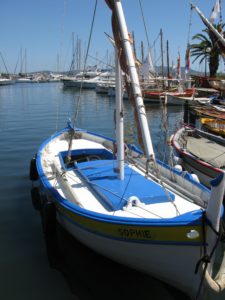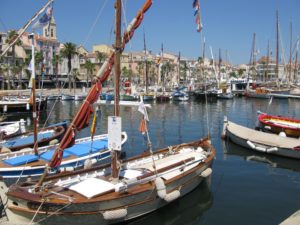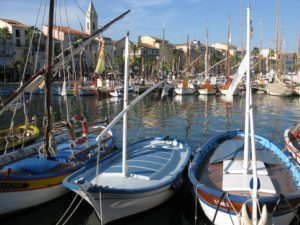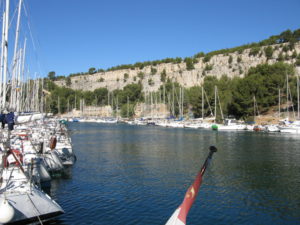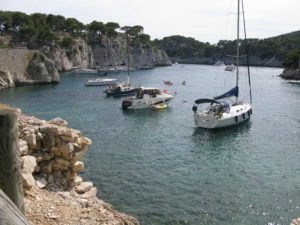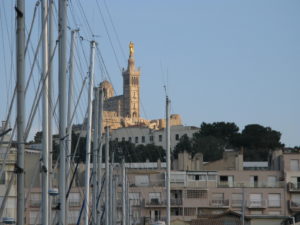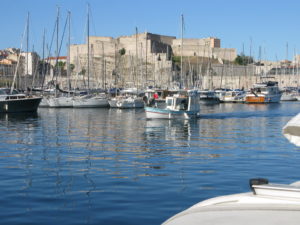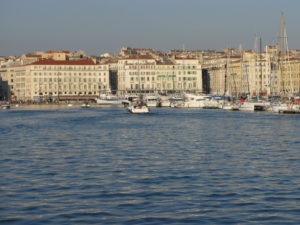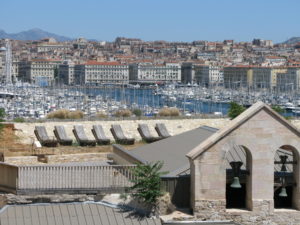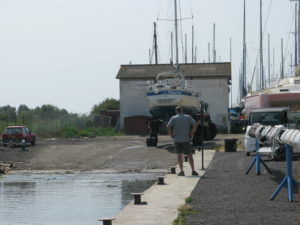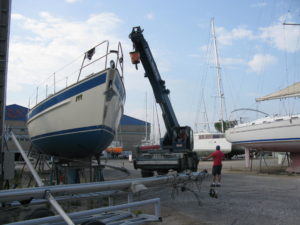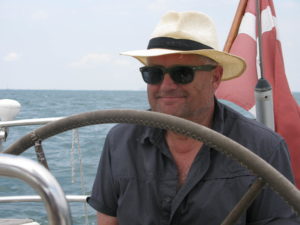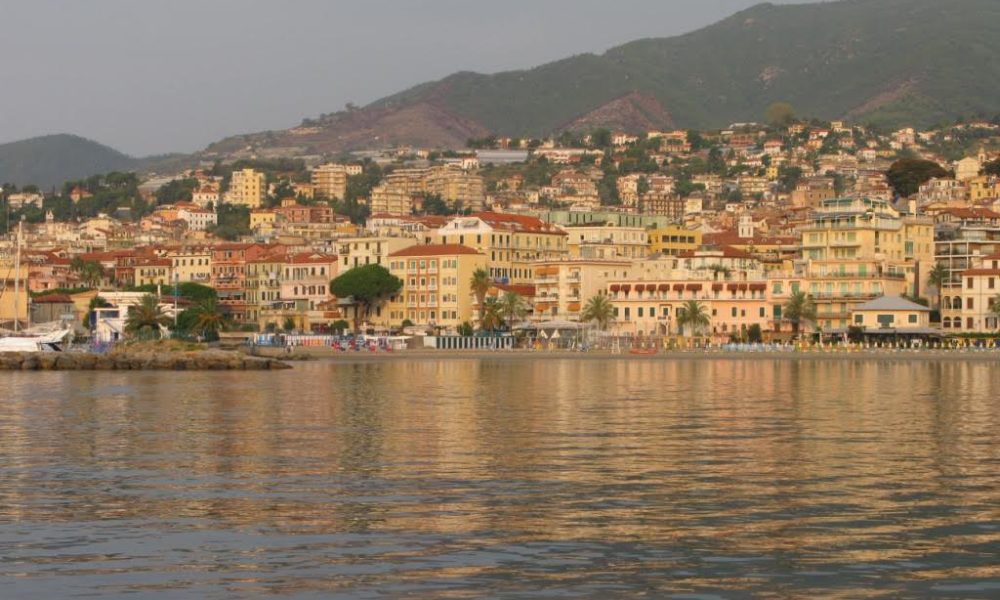
Wonderfull to be surprised by the unexpected. Loano is magnificent
44° 7′ 58.8792” N 8° 16′ 1.7724” E
September 25, 2016
We set sails for Finale Liguria. Our british friends, Derek and Claire, have researched on the internet, and they concluded, that in Finale Liguria you can get a mooring for “just” 48 € a night. After having fought for hours directly against wind of 11 meters per second, we find this too tiresome and hard. We decide to look for an earlier port.
At first we call the city Alissia on VHF channel 9. But they are having a regatta – the harbour is crammed. Instead, we choose the next port, which is the city of Loano, which we know absolutely nothing about. It is hardly mentioned in our guide books.
Loano is an enchanting acquaintance. It is a popular city. Full of life. Obviously this is, where the Italians themselves go for beach holidays, there is a party going on in the city from early morning with playgrounds, marketplaces, cafes and scores of private beaches.
The port is newly built. Large landscaped. Nice thought. Visionary. The middle part of the port is built in a a maritime style – like a giant ship – with port offices, restaurants, toilets, shops and business offices. Talking of toilets, we have never met toilet-facilities at the same level of Loanos – private shower-rooms each with a sink, a toilet and a bidet. First class. Absolutely.
Not all offices and shops have been rented. There is still some way to go, before the harbour fulfills its ambitions, and it may be the explanation for the prices, we are faced with for staying overnight in Loano. An berth costs 52 € for a night. “Hey”, we say. It’s cheaper than in Sanremo. But then they throw in the joker: You can get three nights for two night price.
Hallo! Three nights for € 104. It is 34.5 € per night. We are back at french prices!
Loano is a city without a single spectacular sights, but the city is a charming attraction in itself It gives us an insight into the way regular Italian lives, relax and have their holidays. And we experience how a city works, when it is not yet – as French and Danish cities – have been taken over by large retail chains.
The shopping structure is very much like in Denmark som decades ago, based on small specialist shops. The butcher also sells water and wine. The shop with fresh pasta also sells prepared meals. The bar sells wine out of the house. And the baker deliver pizzas and foccacie sandwiches.
It is a zig-zag running among the shops, it take hours to shop for a meal. Skippers wife think it is charming and incredibly great.
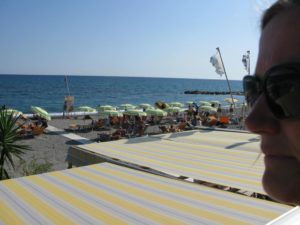
Beaches are good and private. Off season prices in september are 12 € for two sunbeds
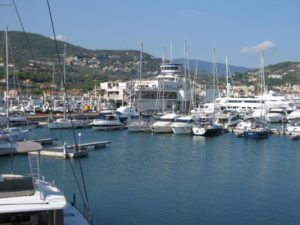
Marina of Loano. Great architecture. Excellent harbour
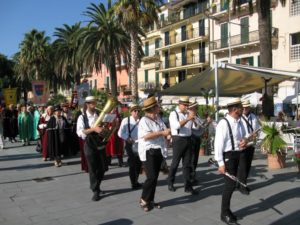
Loano is a very lively city with music and parades
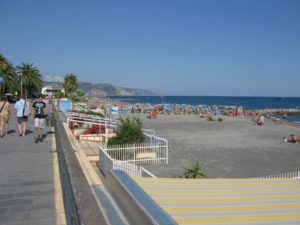
Loano is kilometers of sandy beaches
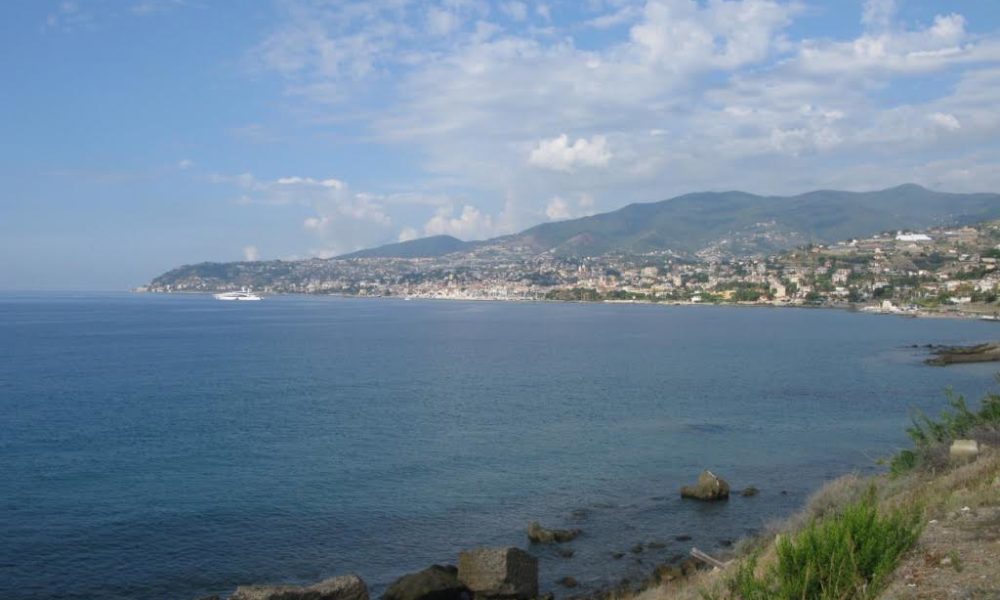
Love at first sight in Sanremo
43° 49′ 6.1788” N 7° 47′ 16.2168” E
September 22, 2016
The big topic of conversation among sailors arriving from France to italian Sanremo, is the exorbitant high port rates. “Horrible! It is twice as expensive to be in a port in Italy as in France! We did not expect this,” says Derek Williams in his boat, Red Rooster, from England. He and his wife, Claire, searches for alternatives and finds an unauthorized berth without water and electricity in Sanremos old municipal port. Here they moor for free in two days.
It’s a bit of a surprise to move from France and into Italy. Over the months we have been accustomed to a French price level, which essentially is 31-35 € for a night in all the old harbours of the major cities, when we arrive with an 11 meters long and 3.5 meters wide sailing-yacht. Only a few times the price has been higher like in St. Tropez and Porquerolles.
It does seem odd, that the price of in first italian city, we run into, is 66 € for a berth, that in many respects is inferior to many french harbours – much longer distance to the bathrooms. Noise on the quay in the evening. Quite a distance to the shops in the city. And a totally useless wifi.
€ 66! For what?
Nevertheless we stay another two days in Sanremo’s new port, Porto Sole, and we discovers that Sanremo is a truly fascinating, a really delightfull city.
The city mixes ancient grandeur and richness with modern shops, and yet we get the feeling, that here time stood still for a several decades. You buy milk and cheese in shops like dairy stores of the 1960’ties in Denmark, and there are so many more small specialty shops, than we are used to in our part of Europe.
A disused railway along the coast have been converted to 24 kilometers of beautiful bike path. We work the pedals of our sailing boat-bikes, and we have a wonderful trip out and a wonderful trip back.
After the bike ride, we find ourselves a large café in Sanremo, where we make observations about the differences between italian people and french people. It seems as if the italians are more happy, more unpretentious and more open than the french. Could this be prejudices? Perhaps. But it is like a great party to sit at the coffee shop in Sanremo. There are shouting and laughter and clashes on the shoulders and on the outermost rows of the café sits the old people of the town, watching the fun with a cup of coffee, that has to last half a day.
It may well be, that port dues are higher in Italy, but our impression is, that the prices for food and beverage in a supermarket or in a restaurant are quite a lot cheaper than in France. Our estimate is, that high harbour fees, are reasonable balanced by cheaper prices for food and beverages.
For us, Italy is love at the first sight.
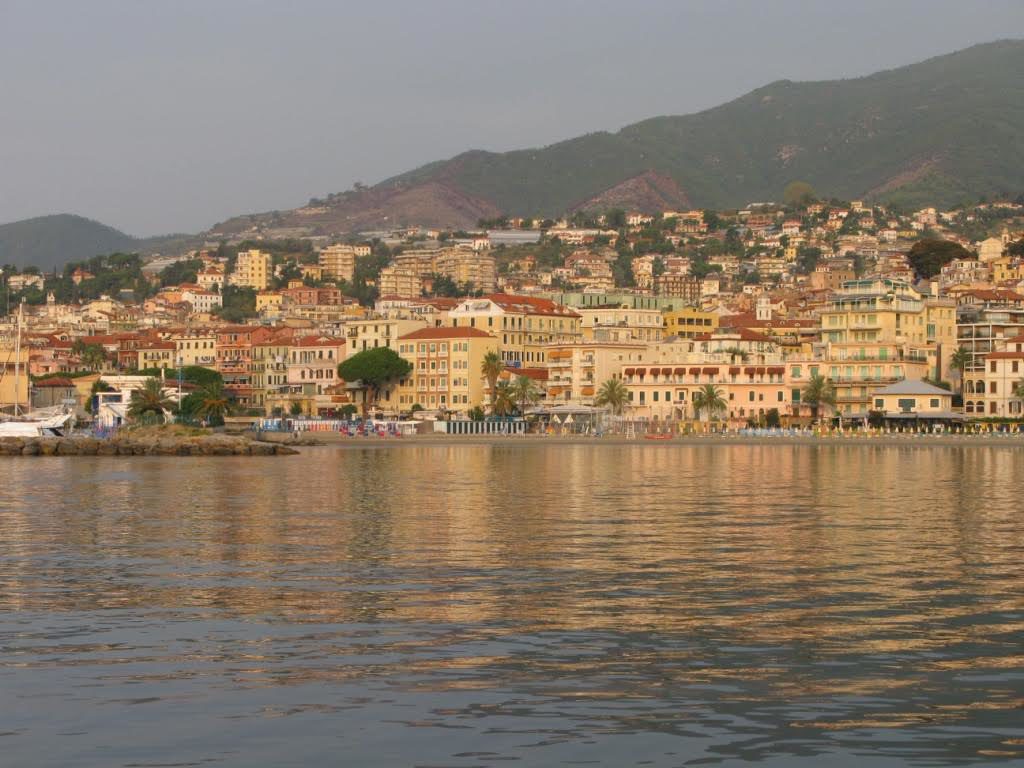
Sanremo deserves more than the two days, we were able to spend in the city
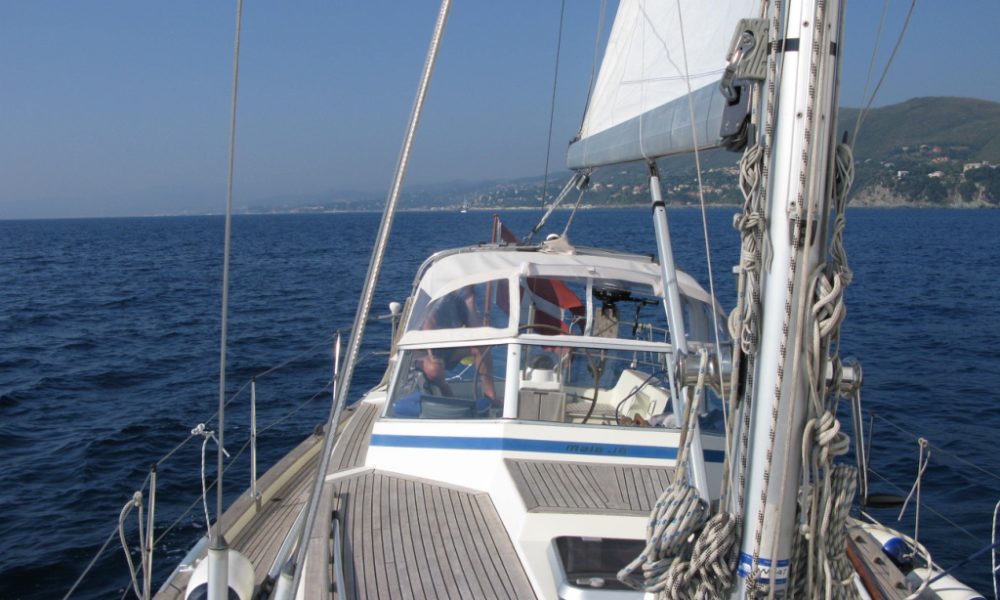
Never take no for an answer – when it comes to a berth
43° 35′ 2.1804” N 7° 7′ 41.7288” E
26.juli 2016

Antibes is a lovely town. Manageable – with beaches, nice museums, restaurants and an unmistakable maritime character
Antibes: The woman behind the counter shakes her head: “You must understand, that what you are asking can not be considered. We do not hire out berths on monthly contracts in July and August. We only hire out one day at a time, eventually two days and then you can come and ask, if you can hire one more day. Those are the rules. ”
The woman behind the counter has an expression that lets us understand, that our request takes the prize as the month most foolish.
“It’s not the port’s berths. It is the individual owners. We can not know, when the owner comes back and want to use the berth himself. ”
The woman is sitting behind the counter at the port office in Port Vauban, Antibes’ giant port, who reportedly is Europe’s largest marina with over 1700 berths, including a billionaire pier for those boat-owners, who can not settle for two or six employees but has 40 or – in one case – even 60 crew members.
We had asked the woman, if we could rent a berth for our sailing boat Ronja for a month or more, while we were back home in Denmark. Obviously we could not. There are rules. And where we were we all, if rules are not followed?
We leave the harbour office crestfallen. We think, again we have met that French arrogance, where at least some officials have a greater need to show who is the boss, than they have an interest in finding a possible solution with the customer.
Nevertheless: We MUST be in Denmark on August 2. or 3., and we CAN at the earliest be back in the south of France on September 12 . The problem has to be solved.
We take place in Café Felix, who has an acceptable wifi and a decent white wine, and we send a flurry of e-mails to ports and shipyards along the Riviera – from Cannes in the west to Menton in the east.
We would like to have Ronja to lie in the water from August 2 to September 12. But we are desperate enough to make a comprehensive agreement for the entire winter, including getting the boat taken out of the water, if the other ports also rejects having her in the water for more than a month.
We get the fastest responses from those, that we seek out personally. Three yards/boat repair shops in Antibes each have a crane large enough to lift Ronja out of the water. All three are sincerely accommodating to our problem. One says, however, straight out that he can make more money utilising his port area to prepare and repair boats than to have our Ronja standing in hibernation. Fair enough.
Another oat repair shop offers to take Ronja on land and store her in a corner of their port area until April, eight months for the price of 7.500 €. A shipyard offering to hive Ronja on land, take the mast of her and carry her into the country, where they have a storage space. Price: 8.200 €.
Thanks. But no thanks. On these terms we will not take Ronja out of the water.
So begins the answers ticking in via the mail. The most professional ports, the four ports that are part of the organisation Riviera Ports – Cannes, Nice, Golfe-Juan and Villefranche – acknowledge immediately with a standard mail, that they have received my mail, and that they will answer the question within 48 hours.
Three of them actually do this. Nice offers to cover part of the period. Cannes and Villefrance says no but they will put us on the waiting list. We do not hear from Golfe-Juan. The same applies to six or seven other marinas. No responce at all. Not a single line.
And yet. One port answers. The most surprising of them all.
We basically had received oral refusals from Port Vauban, but when we sat down and wrote mails, we also sent Port Vauban an email.
And, big surprice! Port Vauban answers yes, they have a place to Ronja from August 2 till September 12.
Hooray for Port Vauban! The port of Antibes is back in the lead. We acknowledge with a yes to the conditions and promise to be there on August 2.
And what did we just learn here? We learned that one hand in a port office do not necessarily know what the other hand is doing. A refusal from one employee can become a happy acceptance from another. Never take no for an answer – when it comes berths.
Reflection: In the four years we’ve been sailing out into the world with Ronja, many have asked whether it is not hard to set aside our boat when we are at home in Denmark and work many months. On the contrary. It has been easy. Easy in Holland. Easy in northern France. Easy west of Marseilles. The French Riviera proved to be a little more difficult and more expensive. But anyway: Again a solution could be created in a short time.
You pay for it. In our case, we pay € 1,082 for 40 days in high season. But as I said: We just had to go back to Denmark on August 2.
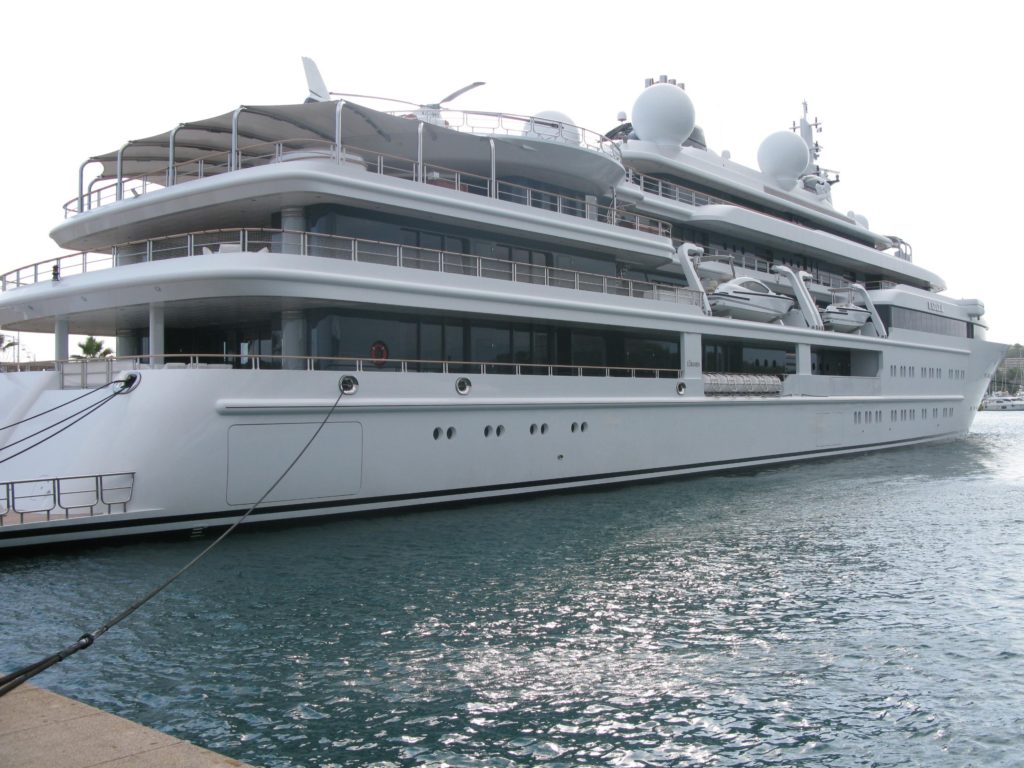
Our “neighbours” in the Antibes, Yacht “Katara”, is 124 meters long, has a crew of 60 and is owned by the emir of Qatar. Price: 300 million $
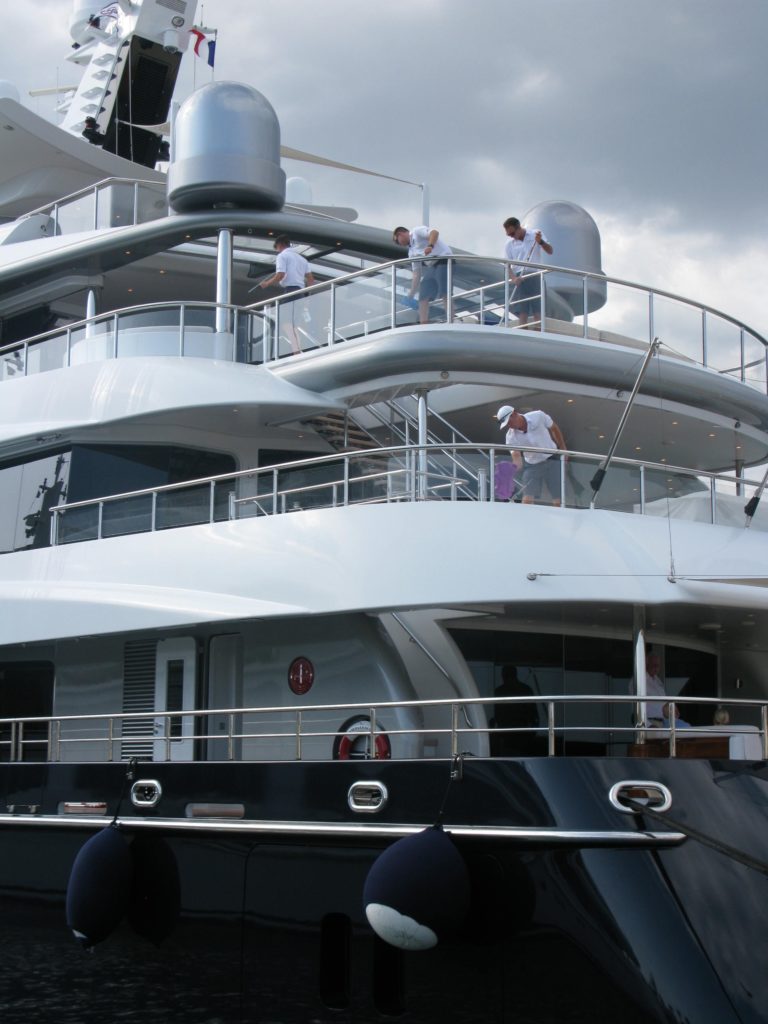
There rinsed, scrubbed, rubbed and polished. Employees at billionaire yachts clean constant when the yacht is in port
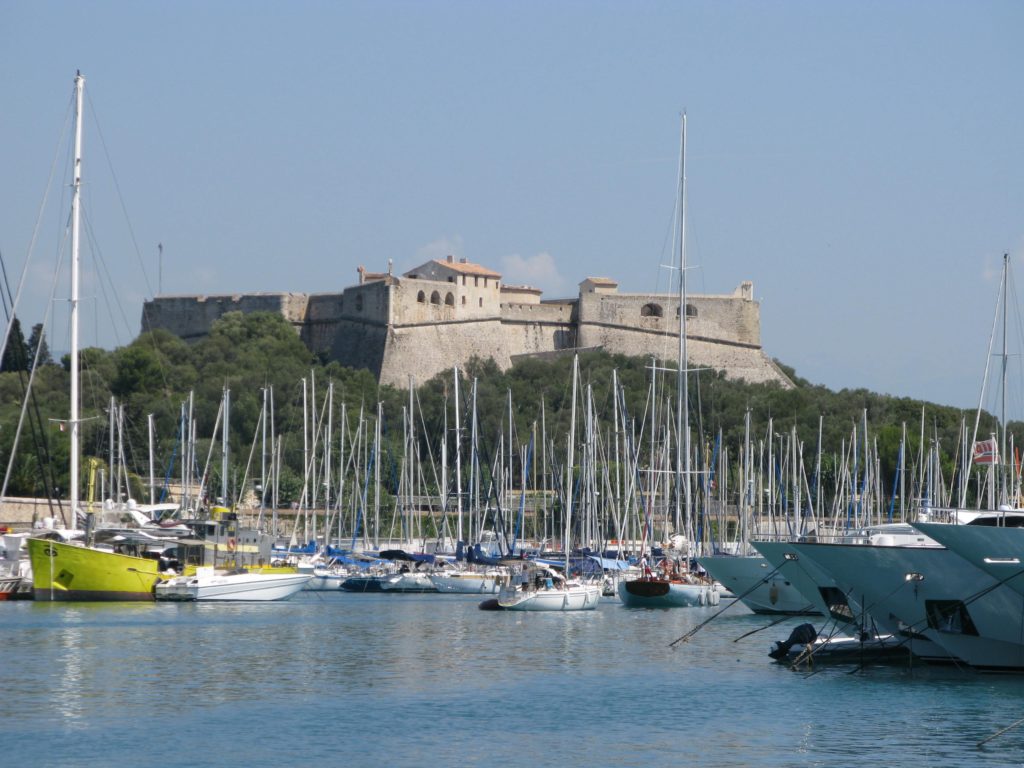
Antibes is said to be the capital of the yacht industry. Here you can buy a billion-boat, get signed up as a sailor, have new uniforms for your crew 🙂
Cannes beats Saint Tropez with several lengths
43° 33′ 10.2492” N, 7° 1′ 2.5284” E
July 16, 2016
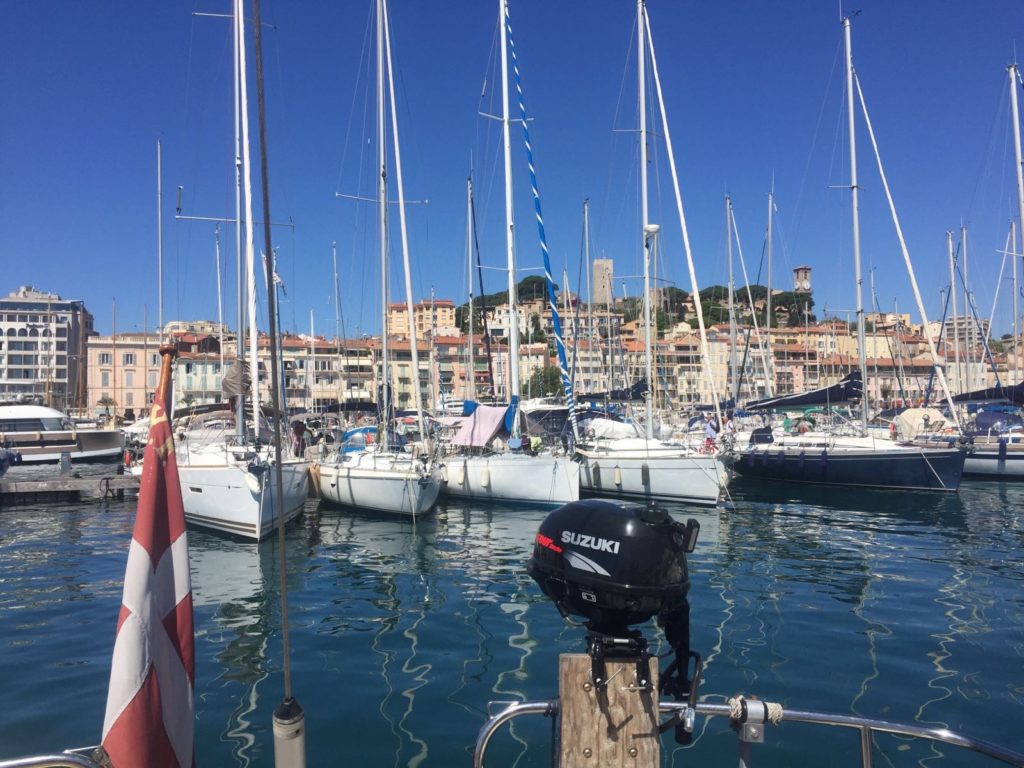
The waterfront in Cannes exudes diversity. Large boats, small boats. Here Ronja feel at home
The air is filled with helicopters over Saint Tropez and Cannes. As industrious insects they are buzzing back and forth between the cities with occasional forays out to the large yachts, each having its own helicopter pad. It seems there is especially dense morning and after-work traffic of people going to and from the job from the villa or the yacht in Saint Tropez, Cannes or Nice.
But what do we know about it? Ronja has no helicopter platform on the aft deck. On reflection has Ronja not even an aft deck. The many helicopters give a sense of business activity, but they also underline the atmosphere of exclusivity and extravagance, we have approached as we close in to Saint Tropez and Cannes. The port of Saint Tropez gave us shelter during almost three days of summer storm with up to 8 Beaufort gusts, and now we have been three days in Cannes so far.
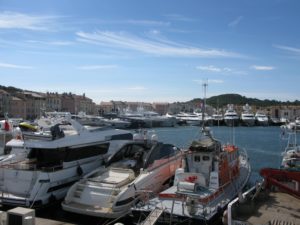
Maybe we are just narrow-minded? But the balance between incoming luxury and the city itself seems lopsided in St. Tropez
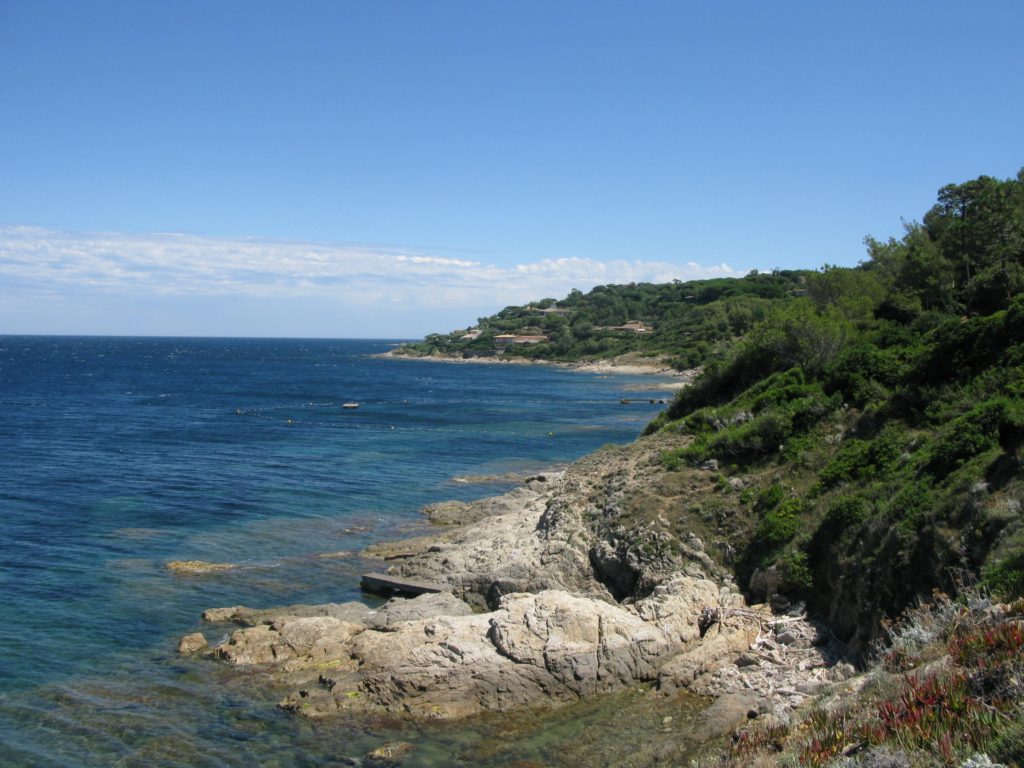
This hiking trip you really must try. The Tourist Office advises against it. “It is too long. Better to go in a car”. But it is a unique nature experience..
Of the two cities, we prefer Cannes. There are common features between the two cities. But Cannes by far wins in comparison. Why? Because there is a nicer atmosphere in Cannes. Cannes is not as outlandish as forlorn as hysterical as Saint Tropez. It is as if, Saint Tropez is nothing in itself, but is instead defines its own value in the things it pulls from the outside – the large yachts, the numerous brand stores, the famous and the rich.
It probably has been like this for many years. After World War II when people wanted to restore the war-damaged city, Saint Tropez was aimed at cultivate a special reputation as a playground for the famous. Errol Flynn came to town, Jean Cocteau, Anaïs Nin and in 1956 also Brigitte Bardot. Thus was the special image in place.
The image is still cultivated. The cruises sail round with tourists, pointing out the villas of the celebrities. The large luxury yachts gets the room innermost in the old harbor, so we all understand that this is the real attraction of Saint Tropez – a sneak peek into the incredibly rich people’s world; tourist fathers and –sons strolling also along the quay discussing how it would be just to work at one of the huge yachts.
Things are different in Cannes. Here the city is larger and can better accommodate all extremes. Here’s also luxury yachts, but they lie at the outer pier and is just one of many elements in the city’s port. Here are also tourists, but the city’s size ensures that it remains predominantly a French town. There are also international brand stores, but they do not overshadow the many local specialist shops with cheeses, pates, bread, hardware, fruit – not to mention antique markets and the daily, quite lavish, food market, Marché Forville.
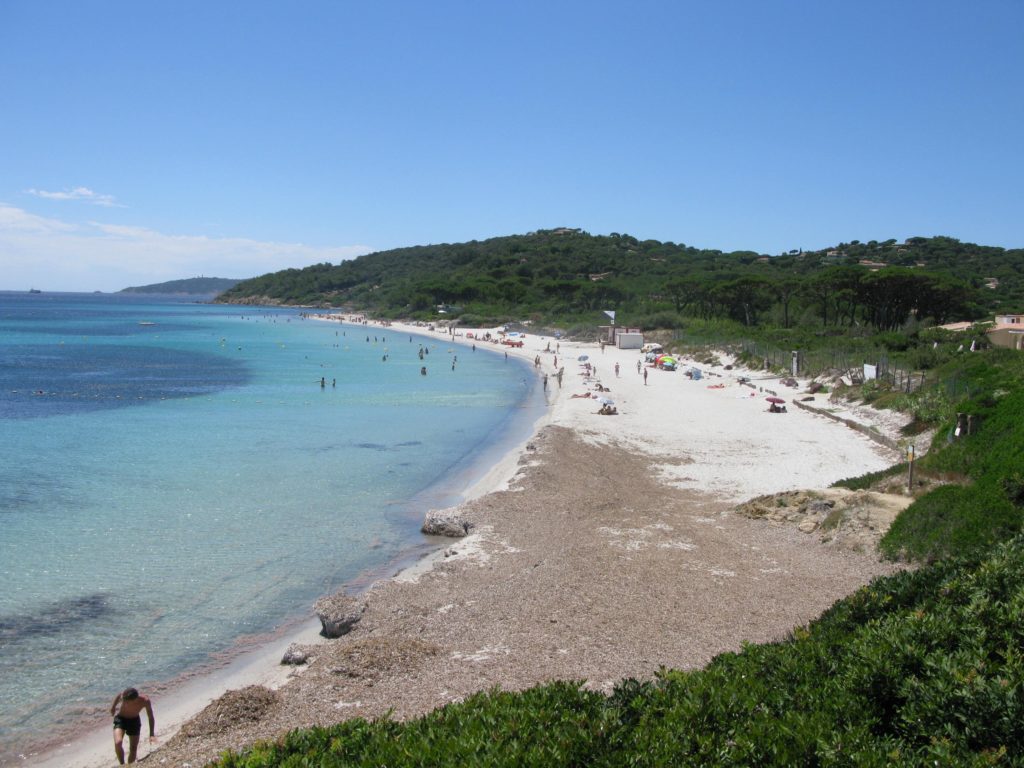
One of the beaches of Saint Tropez: Les Salins. It is located far from the city but is probably among the best we’ve seen.
Unless you just are missing a Gucci bag, shopping-conditions are also best in Cannes – among other things with a few good supermarkets close to the port. The best we saw in Saint Tropez, was a fabulously beautiful hike on a narrow cliff path around the peninsula of Saint Tropez and out to the great beaches Les Salins and Pampelonne. The trip is very long. It is possible to take small swims along the way. Take plenty of water from before going.
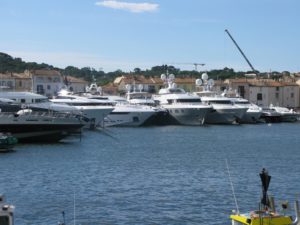
Vulgar? Frankly, yes. Saint Tropez lets the luxury yachts “overshadow” the city, as if visiting wealth is the city’s main attraction
Fact: A port space for Ronja in Saint Tropez: 59 € per night. A space in Cannes: € 34 per night (with better facilities). A pizza calzone in Saint Tropez 18 €. A pizza calzone in Cannes: 15 €. Saint Tropez has a small but very interesting museum of modern art. It’s called l’Annonciade and admission is € 6.
The price of a clean conscience: 19 Euro
43° 25′ 8.8328” N 6° 51′ 29.1552” E
15th of July

In search of the perfect azure sea. When the sea match skippers wife’s toenails, we are there
Barely have we anchored Ronja at a vacant anchor buoy in a beautiful, beautiful bay, Rade d’Agay, midway between St. Tropez and Cannes, before a dinghy comes rushing.
“It will be 19 Euro, please,” says the young guy in the boat.
“19 Euro? For what,” asks skippers wife. “What facilities do we get for the money?”
Well, answers the young guy; there’s shops ashore, toilets, and also showers ashore.
But we do not have any inflatable boat. We are not going ashore. We can not, since we are out here in the middle of the bay by a buoy.
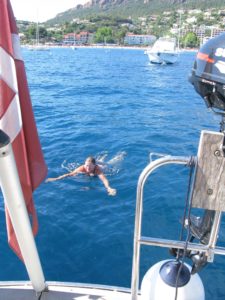
First in the water: Skippers wife
“No problem. I’ll come and get you for 3 € per time” the port captain’s enterprising apprentice answers.
It is a wonderful bay. It was used as anchorage already when the Romans ruled the Mediterranean. And in August 1944, the Americans landed 20,000 soldiers in Agay Bay as part of the offensive to liberate France from the Germans. Today the bay is characterized by the beach and sailor life.
Later we read that it is the authorities who have established 123 mooring buoys around the bay to protect a particular species seagrass in the bay (in English called the Posidonia Grass). The grass is vital to maintain balance and animal life in the sea, and by establishing firmly anchored buoys, the authorities prevents that the sailing boats destroys with the sea floor with their anchors.
Oh well. So 19 € maybe is not that wrong.
As we get ready to depart the next morning, we hail a port guard who passes in his dinghy, waving a black garbage bag and asks if waste disposal is part of the port charges of 19 €.
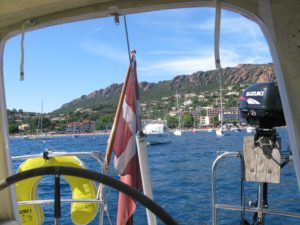
The wind is in the south, straight into the bay, less than five meters per second
He points further into the bay, where we did indeed wonder about a shapeless thing, moored, almost an oversized teacup from a Disneyland-carousel. We sail there and discover: It is a floating garbage container.
Having deposited the last days of waste and with a clear conscience in relation to the important sea grass, we find that this is what you get for 19 € in the Agay Bay.
Facts: the 123 buoys are built in three different zones in the bay. Those who are more economical than us can anchors outside the zones with their own anchor. It costs nothing. But then there’s of cause the conscience thing.
Save the port fee and go straight for the beach
43° 0′ 3.6612” N, 6° 13′ 18.0048” E
July 8, 2016
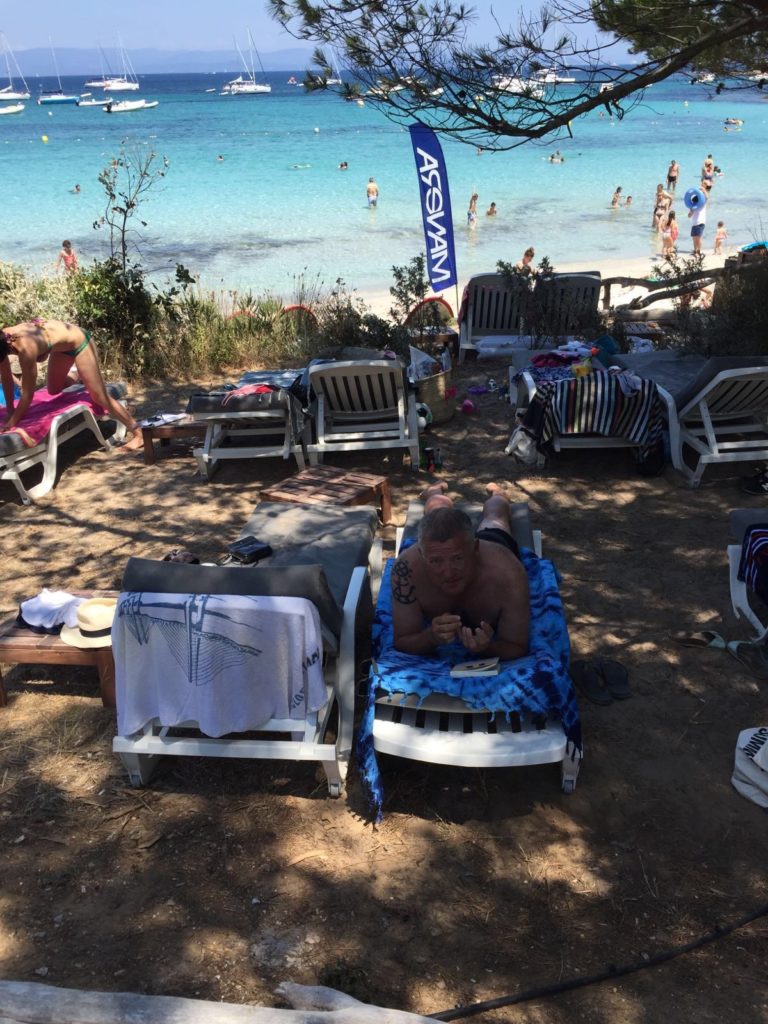
My soul, what do you want more?
Imagine it before you: A soft reclining chair under a huge, shady pine. A bottle of cold water within reach, a crime novel in hand. The distance between the chair and the azure waters is just ten meters of perfect sandy beach, and ten steps to the side is a small restaurant with a daily menu for lunch.
The place is Porquerolles. The largest of the four islands in the archipelago of Iles d’Hyeres, a short distance east of Toulon. Porquerolles is a mixture of a Caribbean island paradise, the Freetown Christiania in Copenhagen and a military barracks. The island offers simple vacation at sky-high prices.
Porquerolles city was built 100 years ago by the French military. Complete with fort, church, officer housing, barracks and exercise tracks. Today, all the buildings taken over by civilians – bicycle rental shops, ice cream vendors, vegetable grocers, ship wrights and restaurants for every budget. Taken together it has created a relaxed, alternative charm, which by mid-July has the additional of a week-long jazz festival.
The island’s focal point is the many beaches. Some have stone beach, others have the finest sand beaches. Everywhere has a sandy surface under the water, which by the way is nicely separate from the many sailors who are anchoring off the beaches. Tourists at foot and by bicycle walking the many kilometers on the way to and from the beaches. It can be a hot journey, but the ride is greatly mitigated by the enchanting aroma of dry pine needles and fresh saltwater.
Plage de Notre Dame is reputed to be the most beautiful of the beaches. Plage de la Courtade is closer to the city. We, however, prefer Plage d’Argent the most – for it is the only one that has its own restaurant, decent toilets and hire of sunbeds.
Facts: Porquerolles is ridiculously expensive. Supply and demand are out of balance. An overnight stay in the harbor, which has few and poor facilities cost 50 € for Ronjas 11 meters, where we are used to paying € 35 per night. A lunch menu at the restaurant cost € 24 for a single right where we are used to get both two and three lunches for € 19 in other ports. The baker is expensive. The supermarket is expensive. Everything is expensive.
A word of advice: Save the port dues and use the island’s many bays for overnight. Bring your own supplies.
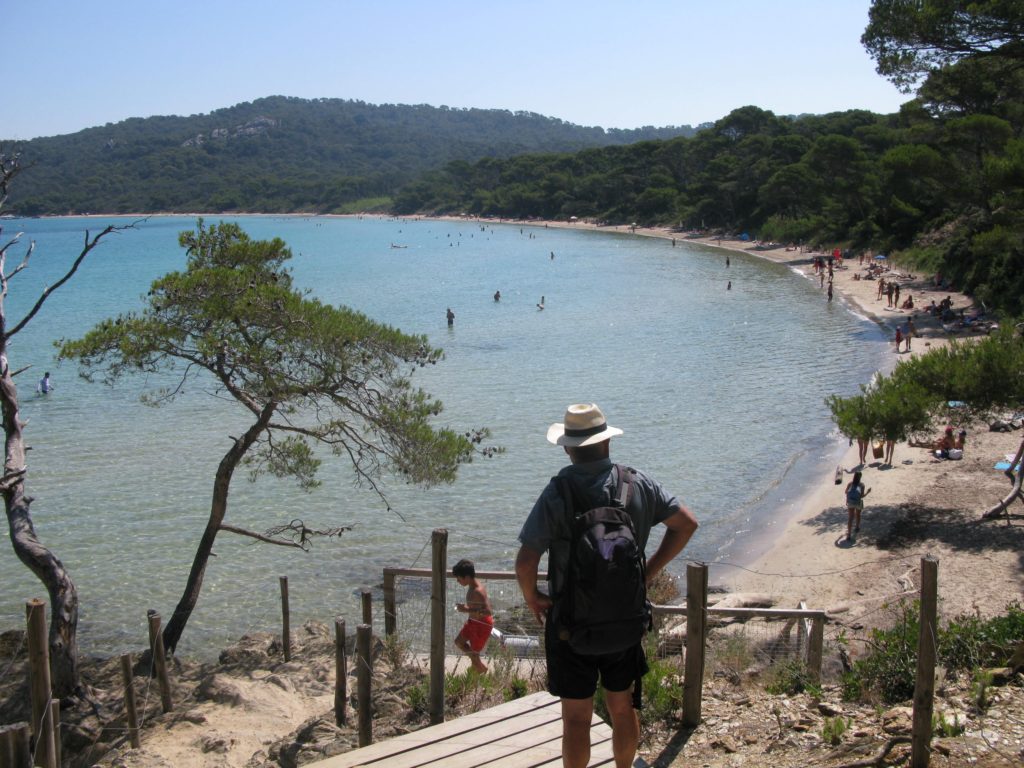
Plage Notre Dame. Isolated beauty – without restaurant
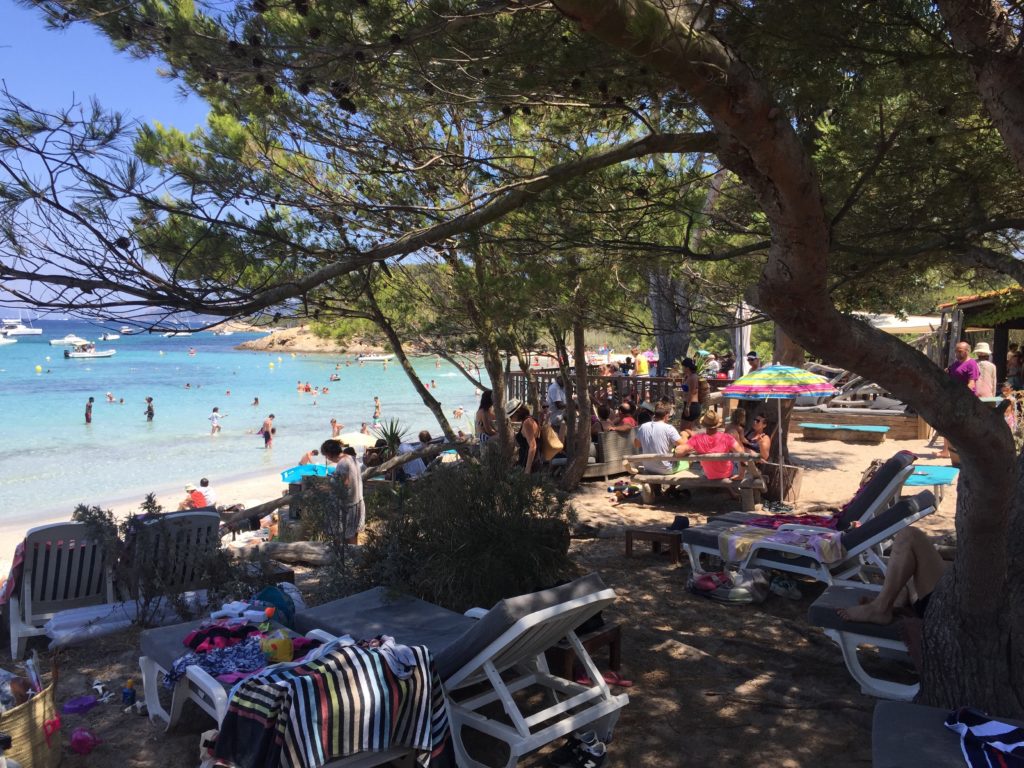
The pine tree is a beautiful tree. Both its shade, its odor and its dryness
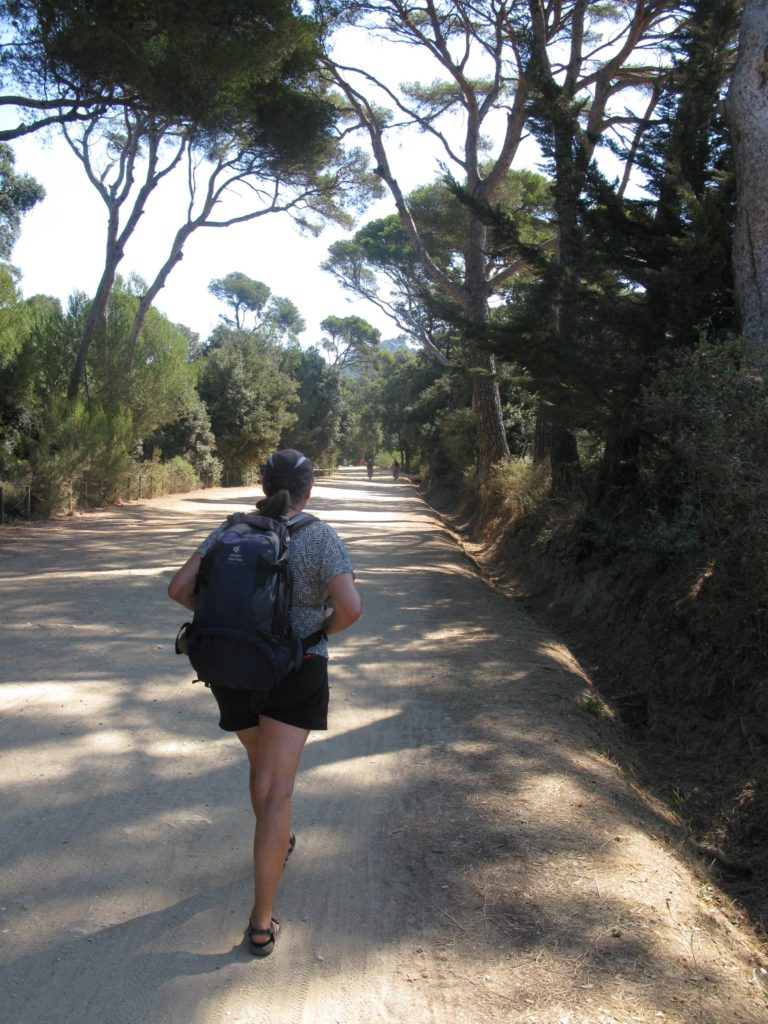
Skippers wife heading to Plage Notre Dame
Cities must have a soul – otherwise we sail on and find a better one
43° 7′ 14.82″ N, 5° 48′ 15.79″ E
July 7, 2016
Frenchmen have difficulty with the name of our boat, “Ronja”. In Sanary-sur-mer, we have previously signed up via cell phone, but when we enter the harbour master’s office, there is no recognition, when I spell “Ronja”. The person who accepted our call on the phone, had written our name as “Oneyeah”.
Knowledge of Astrid Lindgren’s writing in general and “Ronja Røverdatter” specifically is not deep in southern France.
Sanary-sur-mer is a very fine acquaintance. It is the neighboring city to the more famous city, Bandol. But we fancy ourselves that it is a more interesting city. It’s beautiful in the Provence-way with beige, ocher, white, dusty buildings interspersed with harsh green or blue shutters on the windows. The city has fishing boats, daily fish market, beautiful scenery, very few brand-shops and an excellent beach. There is such a little “People and robbers in Cardamom Town” (norwegian story) over it. With the tower and all.
The city has soul. One senses that here is life, even when the tourists have gone home. The city has cultural, architectural, historical, commercial and landscape values, that do not cave in during periods when only the permanent residents are here.
This need – that a city should have an independent soul – is no given thing in these parts. Some days later we call Cavaliere sur-mer. Fine port, good facilities, everything is neat. But the Cavaliere-sur-mer is obviously a city, that lives and breathes with tourism and not so much else. Close to the port is build a brand new entertainment district consisting of 20-30 restaurants and nightclubs plus a single carousel. The party goes on late into the night, but it’s hard to imagine the city as more than a ghost town, when beach tourists have gone home.
Do we sound as if we are sour having moored Ronja in the middle of a flashing disco? Well, it may be right.
Paradise on Earth – Calanque de Port-Miou
43° 12′ 20.16″ N, 5° 30′ 55.01″ E
July 5, 2016
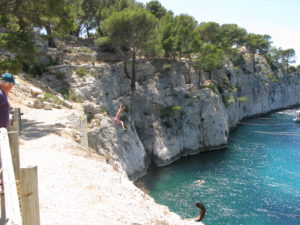 Until this day we had no idea, what a calanque was. We know that now. And we are excited. A calanque is a bay or – in the most exciting form – a narrow and deep fjord that cuts into a rocky
Until this day we had no idea, what a calanque was. We know that now. And we are excited. A calanque is a bay or – in the most exciting form – a narrow and deep fjord that cuts into a rocky 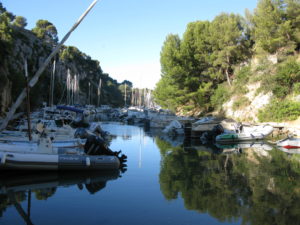 landscape, so the sides are almost vertical and can be up to 100 meters high.
landscape, so the sides are almost vertical and can be up to 100 meters high.
When you’re inside such a calanque, it feels a bit like sailing in a cathedral. Devoutly we look up and on the steep rock faces, enjoying the scent of pine trees and listening to the cicadas anthem. We sailed into them all, right from the first appeared a few miles after Marseille.
After checking all of them, we chose to settle down in – we think – the very most charming: Calangue de Port-Miou. Some calanques are boring, not much more than a wide cove with a blunt beach at the bottom. But the closer we get to the town of Cassis, the calanques are deeper and more characterful. First Sormiou, then Morgiou and later Calanque d’En Vau and Calanque de Port Pin. They are in their own way exciting. But none can compare with Calanque de Port-Miou.
At first glance it seems, that Port-Miou is just larger than the others with more places for mooring boats – with an anchor bend at one end and a rope wrapped around a rocky outcrop or, at best, a ring at the other end. But it is only at first glance.
Pout-Miou has a kind of anteroom, where there is room for 20-30 boats, and where there is a daily cruises from major cities nearby, where guides tell tourists about the calanques. But the trick is to proceed. Even into the bottom of the front room, for here is revealed 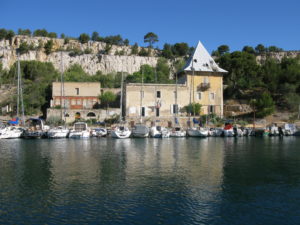 another room, much narrower, much longer, almost one kilometer long. On either side of this narrow space, there is built a “catwalk”, a slender wooden bridge, on both sides. And here hundreds of locals have their permanent mooring. As in a secret inner compartment.
another room, much narrower, much longer, almost one kilometer long. On either side of this narrow space, there is built a “catwalk”, a slender wooden bridge, on both sides. And here hundreds of locals have their permanent mooring. As in a secret inner compartment.
When we call the harbour master on channel 09 and ask for a berth, he refers us to the anteroom. We have no desire to go there. “We can see that there are berths available along the wooden bridges,” we insist. An inflatable boat shows up and we get assigned a berth. A wonderful place.
It is a small paradise. The water in the narrow canyon’s cold and clean and perfect to cool the body under the relentless sun. It is quiet. Not a sound from the tour boats in the front room. Only the cicadas. Occasionally a few kayakers or a single French man working on his boat.
Fact: It is primitive. But Frenchmen has an understanding for the value of beauty, so the price for an overnight stay in Port-Miou is the same as in Marseille, just over 35 €. And this is without electricity, far to the water connection and a 10 minute walk to the bathroom on the other side of the divide. Shopping is a 25-minute walk from Port-Miou in the town of Cassis. However, there are both bus and mini train, for those who do not bother walking.
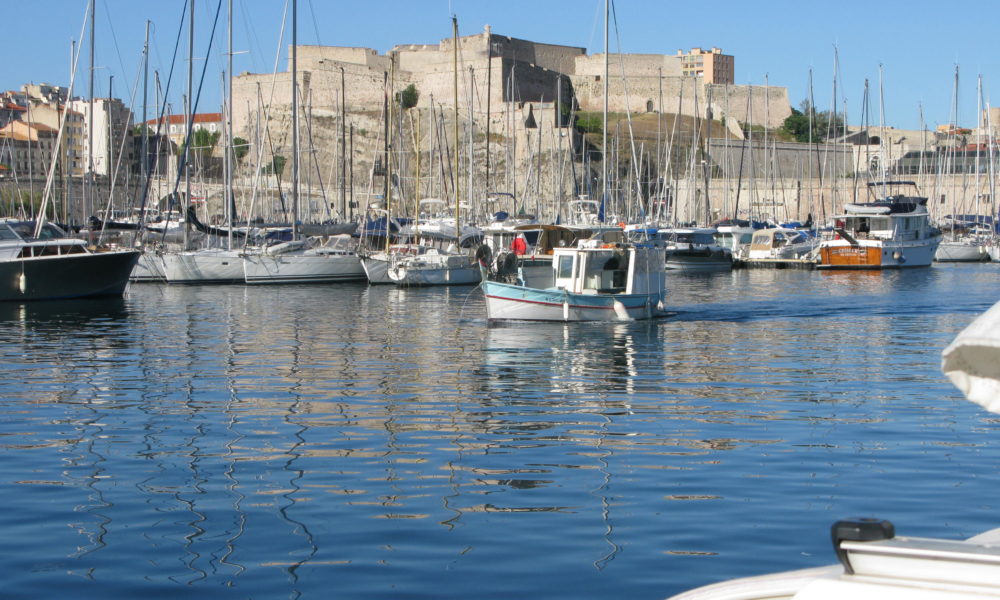
A voice from above – welcome to Marseille
43° 17′ 47″ N 5° 22′ 12″ E
July 2, 2016
“Ronja!”
The name of our boat thunders down upon us.
A voice from heaven?
Or the voice of the harbour-master shouting through a loudspeaker?
We have just sailed in between the two impressive fortresses that mark the entrance to Marseille’s magnificent harbour, Vieux Port. We look anxiously skyward. The voice continues: “Ronja. Keep in the center of the basin. You will be picked up by an inflatable boat! “.
It has been a terrific sailing day. The first real sailing after Ronja for several summers have worked its way through the French rivers and canals using only engines and having no mast (the mast had gone ahead on a flatbed truck with a German haulier). Now Ronja is reunited with her mast, and with a dizzying amount of water under the keel. The Mistral gave us this morning a loving nudge in the back at Beaufort strength 6. Full sail from Port Saint Louis du Rhone. And now we are in Marseilles
… with the voice from on high. An inflatable boat comes rushing with a port captain and two mates aboard. “How long do you plan to be with us”, the port captain asks. When we say two or three days, he looks skeptical. His facial expression makes us understand, that it will be very difficult. An almost impossible mission.
“Follow us,” he says. And here comes the trouble.
Not one of the nearly 1000 boats in the Vieux Port is located with the bow toward the bridge, as we are used to in Denmark. All boats – and I really mean all – are facing aft end toward the dock. They back in! They are crazy, the French. This kind of stuff we do not do.
Intuitively, we are against. Our boat is relatively long keeled and maneuvering clearly worse backwards than forwards. And why should all absolutely be moored cockpit to cockpit in towards the docks, so everyone can follow each other’s dinner menu?
Some beautiful maneuver it is not either. Ronjas bathing platform wedges under the pontoon bridge, and one of the fixed lines, which we according to the same outlandish French tradition must pick up from the harbour bottom and attach the bow with, gets tangled. The port captain shouts, that we must back up, so his line can come free. His aides giggles. Ronjas skipper refuses to back further into the pontoon bridge in the interest of the pinched bathing platform.
It all resolves itself. It usually does.
But there really is something with the french and arrogance. They invent a foolish mooring technique and require all to use it – as if it were a government decree – and so they allow themselves to frown openly about the unfortunate foreigners who can not figure out how to dock at its port.
But what a place. What a view. What a city.
Everyone should try to be in the middle of Marseilles central harbour and enjoy the special light, the beautiful buildings, the amusement wheel, the beautiful church on the mountain, the relaxed atmosphere of cafes and restaurants that surround the entire harbour while enjoying the intense energy, that is being created through daily fish markets, other markets as well as an endless entry and exit from fishermen, excursion boats and yachts.
Marseille is an underrated city. It still has a reputation of mafia, drugs and other crimes over it. But the city has improved itself. There are renovated houses and new ones. It has created architectural masterpieces in the form of new museums and refurbished shopping centers in old warehouses. Norman Forster has created the covering to the metro station at the harbour. Fascinating.
The crime rate here may still be high, but then it is done in suits, and live a more discreet life than the one we know from Gene “Popeye” Hackmann’s troubles in the films “French Connection I and II”.
Marseille is a very exciting city. Large, magnificent, vibrant, charming and French – with a significant contribution of immigrants from North African countries. You meet very few tourists from Germany, the UK and Scandinavia. Marseille is a French city. So far prefered by the french themselves.
There is nothing but good to say about Marseille. … well, that would be the harbour master’s morbid insistence, that all boats must turn the same way at all the pontoons in the port. Either it’s insane aesthetics, or it is a fascist desire that we all must march equally and concurrently.
Fact: It cost € 37 per night to stay in the Vieux Port. Electricity and water just off the boat. Unique location but some noise at night. Toilets and bath almost inaccessible – they were on the other side of the harbour, a stroll of one and a half kilometer. Port captain said that we could just call, he would pick us up in his dinghy, when we had to use the bath. But to be honest: We came from the beginning a little crooked in to that harbour master.
Again in France, now Mediterranean
43° 23′ 15″ N, 4° 48′ 15.84″ E
June 29, 2016
Our driver is agitated. Why do those women not move their car so he can get past?
Fools! He opens the car window, shouting to the two women, that they should turn into a parking lot, so he can get past.
He did not quite understand the situation.
The two women backed out of their parking space exactly at the same time as our driver and they prepare to drive one way while he prepares to drive the other way. Now it is bumper to bumper. One woman gets out of the car and explains that this road is one-way, and that he is heading in the wrong direction. Therefore he must leave room for them to continue.
He snorts. Women. “Oh, la, la“. With his hand, he shows that these very women are impossible to explain to. “Je suis importante,” he said in a last attempt to win the match. “I am important.” It makes no impression. Our driver drives cursing back into position, leaving the women to pass and drives out again, while he mumbles about amateurs, women, people with no respect for authority and rules of the road.
Kirsten and I are sitting in the passenger seats and we see how the large arrow in the roadway show that it were the two women who were right. Our driver is a fool.
And we are back in France. Ready to resume our “circumnavigation in stages” on the good ship Ronja. A Swedish-built Malö 36, beautiful and solid. The past 11 months she has been parked on land 50 km west of Marseille. At Navy Service in Port Saint Louis du Rhone.
Our fool of a driver has just fetched us in the arrivals hall at Marseille airport with a sign from Navy Service: “Mr. Jensen “. It’s us. He is certainly 80+, looks like an angry Santa Claus with a white beard and rimless glasses, speaks only French and has probably exceeded the expiration date on his driver licence. When we came out from the arrival hall of the airport’s parking lot, he could not remember where he had put his car. Wait right here, he said and circled aimlessly.
Sigh. Who are we going to entrust our life here? He finds the car, we throw our two soft bags into the back – and then comes the two women and insist on their right. It’s not his day, this driver.
Navy Service is a great place. They have 1,200 boats in winter storage on land. They have specialized in lifting the ships on shore, park them and later – after several months – to put them in the water again. Others cannot. They operate cranes – boom cranes and ship cranes. And they are good.
In the living area – like some parasites – a dozen small independent craft businesses are operating. Some of these may prepare your engine for the winter, other repair epoxy damage, others can sew your storm- and cold- resistant nordic cockpit tent into a light and airy, Mediterranean-bimini. It is expensive. But damn it, it’s great.
I think it is a French specialty: Port du sec. Dry ports. Large paved or gravel areas where French and globetrotters leave their boats winter storage with masts on. It protects the boat against fouling, let them dry out and perfectly suited to those who still have only a sailing season of a few months.
Even with help from local craft people we sailors often forget, how much work it takes to make a sail boat ready to sail. The mast must be cleaned. Shroud and stays needs to be adjusted. Electrical installations between the mast and the boat must be restored. Bulbs should be changed. The drain should to be cleaned. Sails has to be put on. Defective parts replaced. Everything must have cleaning and polishing. Water and food should be stored.
It takes days. More time than anyone just walk around and remember. We get it all done, even if the sun above the Rhone delta is relentless. We prefer to work early morning and late evening, and at night we struggle with mosquitoes.
While we work we sometimes get a glimpse of our driver from the airport. He seems to function also as a worker in Navy Service. Today he drives a truck, moving containers and large bins with a tight-lipped expression.
No need to get in his way. None.
